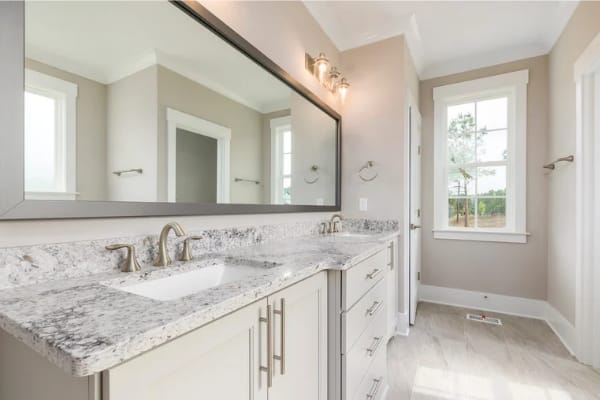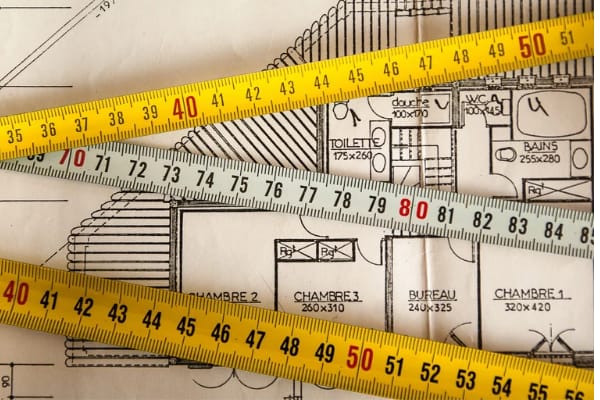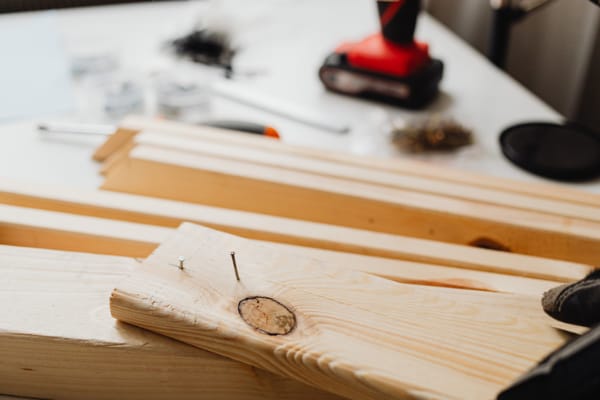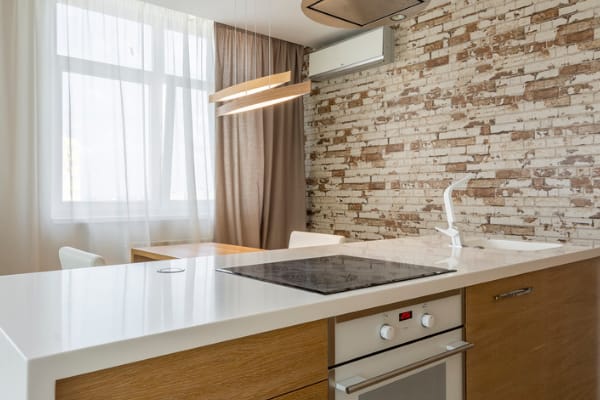Are you ready to transform your kitchen into a sleek, modern masterpiece? Imagine the elegant charm of concrete countertops gracing your culinary haven. In this guide, we’ll unveil the secrets to achieving that stunning, industrial-chic look with a step-by-step tutorial on how to install concrete countertops in your kitchen. Get ready to elevate your kitchen design game to a whole new level!

Section 1: Materials and tools
Certainly! When it comes to section 1: Materials and tools for an installation process involving concrete, it’s crucial to ensure you have the right materials and tools to achieve a successful outcome. Here’s some requirement:
Materials:
- Concrete mix types: There are various concrete mix options available, each designed for specific applications. For instance, you can use a high-strength self-leveling concrete mix for a smooth and polished finish. On the other hand, fiber-reinforced concrete mixes are excellent for added durability and crack resistance in outdoor projects.
- Reinforcement options: Beyond traditional steel rebar, consider innovative reinforcement options like glass fiber-reinforced polymers (GFRP). GFRP offers corrosion resistance and is lighter than steel, making it suitable for structures in corrosive environments or where weight is a concern.
- Admixtures: Explore the use of admixtures like air-entraining agents, which improve freeze-thaw resistance in colder climates. Superplasticizers can enhance workability, allowing for a more fluid mix without compromising strength.
Tools:
- Power trowel with laser guidance: For achieving a perfectly level and smooth concrete surface, consider using a power trowel equipped with laser guidance. This advanced tool ensures a consistent finish, reducing the need for extensive manual finishing work.
- Concrete vibrator with variable frequencies: To eliminate air bubbles and ensure proper consolidation of the concrete mix, invest in a concrete vibrator with adjustable frequencies. This allows for tailored vibration based on the mix’s characteristics and the specific project requirements.
- Non-destructive testing (NDT) equipment: Implementing NDT equipment such as ground-penetrating radar (GPR) or ultrasonic testing devices can help detect hidden defects or voids in concrete structures, enhancing long-term durability and safety.
- Digital moisture meters: Precision is key in concrete curing. Digital moisture meters help monitor moisture levels during the curing process, ensuring that the concrete achieves optimal strength and durability.
Section 2: Measuring and templating

Accurate measurement and templating are foundational steps in the process of creating custom kitchen countertops that not only fit perfectly but also enhance the overall aesthetic and functionality of your space. Here, we delve into the intricacies of these crucial tasks, highlighting their significance and providing unique insights.
Precision in measurement:
- Accurate measurements are the cornerstone of a successful countertop installation. Begin by using a high-quality tape measure, preferably one with a laser feature for added precision.
- Measure twice, cut once: This age-old adage is particularly relevant when it comes to countertops. Take multiple measurements from various points along the countertop area, including corners and irregularities, to ensure consistency and eliminate the possibility of errors.
- Pay attention to details: It’s not just about measuring the length and width. Consider the depth or thickness of your kitchen countertop, as this dimension can significantly impact its durability and appearance.
Note any variations: Older homes, in particular, may have walls that aren’t perfectly straight or level. Be sure to record these irregularities accurately to ensure your countertop fits seamlessly.
The art of templating:
- Creating templates is a meticulous process that involves replicating the exact shape and size of your countertop space on a rigid material, typically thin plywood or cardboard.
- Unique contours and design elements: If your kitchen countertop layout includes curves, angles, or custom features like a built-in sink, templates become indispensable. They allow you to translate these unique characteristics precisely onto the countertop material.
- Perfect alignment: Templates ensure that your countertop aligns seamlessly with adjacent surfaces, such as cabinets and walls, enhancing both the visual appeal and functionality of your kitchen or bathroom.
- Minimizing waste: Templating helps optimize material usage by identifying the most efficient layout for your countertop slabs. This can save you money and reduce environmental impact.
The importance of templates in DIY projects:
- For those embarking on DIY kitchen countertop installations, templates are even more critical. They serve as a reference point for cutting and shaping your countertop material, reducing the margin for error.
- Iteration and experimentation: Templates allow you to experiment with various designs and layouts on paper before committing to the final product. This can lead to more creative and personalized countertop solutions.
- Time and cost efficiency: Although templating may seem time-consuming, it can ultimately save you time and money by avoiding costly mistakes and rework during the installation phase.
Section 3: Mixing and pouring concrete
Creating the perfect concrete mix and pouring it accurately are critical steps in achieving a successful project. Here’s a unique and high-quality breakdown of these processes:
- Measuring ingredients: Begin by carefully measuring your concrete mix components. This includes cement, aggregate (usually sand and gravel), and water. Precise measurements ensure consistent results.
- Adding color and additives: If you desire a colored or specially modified concrete, add pigments or additives at this stage. Follow manufacturer guidelines for the correct proportions and mixing procedures to achieve the desired result.
- Mixing the concrete: Use a high-quality concrete mixer or a wheelbarrow and a hoe to thoroughly blend the ingredients. Mix until you achieve a uniform consistency without any visible streaks or lumps. The ideal consistency is similar to that of thick oatmeal.
- Testing for consistency: Perform a slump test to check the concrete’s consistency. Fill a cone-shaped container with the mixed concrete, then invert it and remove the cone. The concrete should maintain its shape but slightly sag. This test ensures the mix is neither too dry nor too wet.
- Pouring technique: Start pouring the concrete evenly from one end of the formwork to the other. Avoid pouring large volumes in one spot, as this can lead to an uneven surface. Use a concrete vibrator or a wooden float to remove air bubbles and ensure a smooth finish.
- Screeding and leveling: After pouring, use a screed board to level the concrete surface. Screeding involves moving the board back and forth across the formwork to eliminate excess concrete and create a level surface.
- Finishing touches: Once the concrete has slightly hardened, use a trowel to give the surface its final finish. You can choose from various finishes, including smooth, broom, or textured, depending on your project’s requirements.
- Curing: Cover the freshly poured concrete with wet burlap or plastic sheeting to prevent it from drying out too quickly. Proper curing is essential for concrete strength and durability.
- Cleaning tools: Immediately clean your mixing equipment and tools to prevent concrete from hardening on them. This will prolong their lifespan and ensure they’re ready for future use.
- Safety during pouring: While pouring, continue to wear your protective gear, and be mindful of your surroundings. Avoid stepping on the fresh concrete, and if you must walk on it, use wooden boards or planks.
Section 5: Reinforcement and embedding

Reinforcing options like mesh or rebar play a crucial role in enhancing the structural integrity of kitchen concrete countertops. While both serve to reinforce the concrete, they are distinct in their applications. Mesh, often composed of materials like fiberglass or steel, is a versatile choice. It provides distributed support throughout the concrete, helping to minimize cracking and improve tensile strength. When using mesh, ensure that it is positioned at the midpoint of the countertop thickness to maximize its effectiveness.
Rebar, on the other hand, offers targeted reinforcement by strategically placing steel rods within the concrete. This is particularly useful in areas prone to high stress or load-bearing requirements, such as overhangs or corners. Embedding rebar involves careful planning to ensure that it is precisely positioned to provide the necessary support without compromising the countertop’s aesthetics.
When embedding these reinforcement materials, it’s essential to maintain proper spacing and secure them securely within the concrete formwork. A well-organized grid or pattern can also add an artistic touch to your countertop design. Pay attention to the compatibility of the reinforcement materials with the concrete mix you’ve chosen, as this can impact the overall performance and longevity of your countertop.
For those looking to add a touch of uniqueness to their concrete kitchen countertops, decorative elements like glass, stones, or shells can be integrated seamlessly. Glass chips or pebbles can be scattered onto the countertop surface during the pouring phase, creating a mesmerizing mosaic effect. Alternatively, embedding stones or shells into the concrete can evoke a coastal or rustic aesthetic, lending character and texture to your countertop.
Achieving a harmonious balance between the practicality of reinforcement and the aesthetics of decorative elements is an art in itself. The key lies in careful planning and experimentation to achieve a visually striking and durable concrete kitchen countertop that meets both functional and artistic aspirations.
Section 6: Curing and drying

Proper curing and drying are essential stages in the creation of concrete countertops, influencing their strength, durability, and appearance. Curing involves maintaining the right moisture levels and temperature to allow the concrete to reach its full potential in terms of strength and resistance to cracking.
During the curing process, it’s vital to keep the concrete moist, typically by covering it with wet burlap, plastic sheeting, or specialized curing compounds. This prevents rapid moisture loss and ensures that the concrete hydrates fully. Curing time can vary depending on factors like concrete mix, temperature, and humidity, but a general guideline is a minimum of 7 days.
Simultaneously, maintaining the correct environmental conditions is critical. Temperature fluctuations can lead to cracking or uneven curing, so strive for a consistent temperature range, ideally between 50°F to 75°F (10°C to 24°C). Avoid exposing the countertop to direct sunlight or extreme heat during the curing period.
Once the curing phase is complete, the drying process begins. This phase is equally important, as improper drying can result in surface defects or reduced strength. Gradually reduce the moisture content by providing adequate ventilation and allowing the countertop to air dry. This typically takes a few weeks to a month, depending on the thickness of the countertop and ambient conditions.
To ensure a successful curing and drying process, consider using a curing blanket or tent to maintain controlled conditions. Regularly check the moisture content with moisture meters to track progress. Additionally, applying a high-quality concrete sealer after the countertop has dried thoroughly can further enhance its durability and resistance to stains.
By meticulously managing the curing and drying phases, you not only maximize the longevity and performance of your concrete kitchen countertop but also achieve a flawless finish that showcases the beauty of concrete as a design material.
Section 7: Polishing and finishing
Achieving the perfect finish for your concrete countertops is an art that requires attention to detail and patience. To create a truly unique and high-quality finish, consider the following:
- Diamond polishing: Instead of traditional sandpaper or abrasive pads, use diamond polishing pads to achieve a smoother and more refined surface. These pads come in varying grit levels, allowing you to progressively work from coarser to finer grits to achieve the desired level of smoothness.
- Artistic edge profiles: To add a distinctive touch to your countertops, experiment with custom edge profiles. Unique edge designs, such as beveled, bullnose, or ogee profiles, can elevate the aesthetics of your concrete countertops and set them apart from the ordinary.
- Incorporate decorative elements: Embed decorative elements like colored glass, semi-precious stones, or even metal shavings into the concrete mix before it sets. These additions can create eye-catching patterns and textures, adding a one-of-a-kind appeal to your kitchen countertops.
- Acid staining for color variation: To introduce subtle color variations and a marbled effect, consider acid staining the surface. Acid stains react with the minerals in the concrete, producing unique and natural-looking colors that cannot be replicated with traditional paint or pigments.
- Hand-polishing techniques: For a truly bespoke finish, consider hand-polishing certain areas to create contrast or highlight specific design elements. Hand-polishing can bring out the natural beauty of the concrete and enhance its tactile quality.
Discuss sealing options to protect the countertop’s surface:
When it comes to preserving the beauty and durability of your concrete countertops, sealing is paramount. Opt for a high-quality sealer that suits your design preferences and lifestyle:
- Penetrating sealers: These sealers are absorbed into the concrete, forming a protective barrier from within. They are excellent for maintaining a natural, matte appearance while providing superior protection against stains and moisture.
- Topical sealers: If you prefer a glossy or satin finish, choose a topical sealer. They create a protective layer on the surface of the concrete and can enhance the color and depth of your countertop’s finish.
- Enhancement sealers: Consider an enhancement sealer that not only protects but also enhances the appearance of your kitchen countertop. These sealers can deepen the color and give the concrete a wet look, adding a luxurious touch.
- Regular maintenance: Regardless of the type of sealer you choose, emphasize the importance of periodic resealing. This ensures that your countertop continues to look stunning and remains resistant to wear and tear over time.
Section 8: Installation
Installing concrete kitchen countertops is a critical step that requires precision and care to ensure a secure and level fit:
- Custom templating: Before installation, create a precise template of your cabinet’s dimensions and layout. Custom templating ensures an exact fit for your unique countertop design.
- Adhesive selection: Use a high-strength adhesive specifically designed for stone or concrete countertops. This adhesive should provide excellent bonding while allowing for minor adjustments during installation.
- Leveling and support: Ensure that the cabinets are level and properly reinforced to support the weight of the concrete countertops. Use shims and supports as needed to achieve a level surface for installation.
- Seam alignment: If your kitchen countertop design requires multiple sections, carefully align the seams to create a seamless look. Use specialized epoxy or filler materials to blend and hide seams effectively.
- Curing and protection: After installation, cover the countertops with plastic sheeting and allow them to cure for at least 24-48 hours. This helps in preventing any premature stress on the freshly installed countertops.
Section 9: Maintenance and care
To keep your concrete kitchen countertops looking their best and address common issues effectively:
- Regular cleaning: Clean your countertops with a pH-balanced, non-abrasive cleaner and warm water. Avoid harsh chemicals and abrasive scrubbers, as they can damage the sealer and the surface.
- Resealing schedule: Follow the manufacturer’s recommendations for resealing, typically every 1-3 years, to maintain optimal protection against stains and moisture.
- Heat protection: Use trivets or hot pads to protect your countertops from hot pots and pans, as extreme heat can weaken the sealer and potentially discolor the concrete.
- Avoid cutting directly: Use cutting boards when chopping or slicing to prevent scratches and dents on the countertop’s surface.
- Addressing stains: Promptly clean up spills, especially acidic substances like citrus juices and red wine, as they can stain if left untreated. For stubborn stains, use a poultice or specially formulated concrete stain remover.
- Repairing minor damage: For minor scratches or imperfections, lightly sand the affected area and reapply sealer to restore the finish.
Final thoughts
The journey to concrete kitchen countertop perfection may require patience and precision, but the end result is undeniably worth the effort. By adhering to safety measures and embracing the creative process, you’ll craft a one-of-a-kind, resilient surface that will elevate the aesthetics and functionality of your kitchen or bathroom. So, roll up your sleeves and embark on this exciting DIY adventure, knowing that your home is about to be adorned with a timeless masterpiece that you’ve personally created. Cheers to many years of enjoyment ahead!
The article is written by the team of https://kitchenfaucetreviewed.com